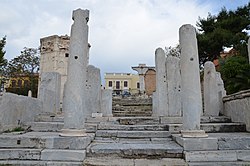
The East Propylon is the eastern entrance of the Roman Agora in Athens. Built in 19-11 BCE, it consisted of Ionic columns made of gray Hymettian marble. [1]

The East Propylon is the eastern entrance of the Roman Agora in Athens. Built in 19-11 BCE, it consisted of Ionic columns made of gray Hymettian marble. [1]